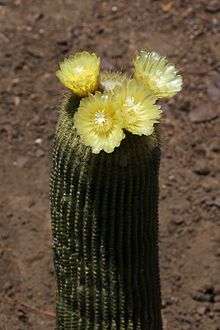Parodia leninghausii
| Parodia leninghausii | |
|---|---|
 | |
| Parodia leninghausii | |
| Scientific classification | |
| Kingdom: | Plantae |
| (unranked): | Angiosperms |
| (unranked): | Eudicots |
| (unranked): | Core eudicots |
| Order: | Caryophyllales |
| Family: | Cactaceae |
| Subfamily: | Cactoideae |
| Tribe: | Notocacteae |
| Genus: | Parodia |
| Species: | P. leninghausii |
| Binomial name | |
| Parodia leninghausii | |
| Synonyms | |
|
Notocactus leninghausii | |
Parodia leninghausii is a species of South American cactus commonly found as a houseplant. Common names include Lemon Ball, Golden Ball and Yellow Tower cactus.
Botanist Karl Moritz Schumann named it after Wilhelm Lenninghaus (1845-1918),[1] a native of North Rhine-Westphalia who, in the 1880s, left his hometown of Ennepetal and emigrated to Porto Alegre, Brazil, where he became Guillermo Lenninghaus, and collected cacti for the German grower Haage.
P. leninghausii is native to the Rio Grande do Sul province in the south of Brazil. In those regions, winter nights are cold, with a light freeze. These cacti survive in these conditions because they are quite dry at that time.
P. leninghausii shows cactus species nomadism; it was successively included in genus Pilocereus K. Schumann 1895, Malacocarpus (K.Schumann) Britton & Rose 1922, Notocactus (K.Schumann) A.Berger 1929, Eriocactus (K.Schumann) Backeberg 1942, and finally ended up in Parodia (K. Schumann) F.H.Brandt 1982.
Description
The species have many thin golden spines. The young plants are globular, then columnar up to 1m tall, 12 cm diameter and about 30 ribs. Old plants cluster from the base. Flowers are yellow, 5 cm diameter, at the top of the plants, but only if adult (at least 20 cm tall)
Sometimes, they present monstruous forms. There is a cultivar albispina with white spines.
Cultivation
As most of the cactus, they need well drained soil, sunny exposure, regularly watering in summer and not at all in winter. In temperate climate, keep them outside in summer. In the wild and in winter, plant accepts frost at -4 °C if totally dry. In cultivation, it is preferable to keep cold temperature, but more than +2 °C.
%2C_Huntington.jpg)
Notes
- ↑ Note: His name was Lenninghaus, but the species is leninghausii without the double "n".
Sources
- Anderson, Edward F. (2001) The Cactus Family Timber Press, Portland, Oregon, pp. 544–545, ISBN 0-88192-498-9
External links
| Wikimedia Commons has media related to Parodia leninghausii. |
- (in French) Photos on www.AIAPS.org
- (in English) photos on www.cactiguide.com
- IPNI Listing
- Kew Plant List
- The flower of parodia leninghausii
- The seeds of parodia leninghausii
- The autumnal flowering of parodia leninghausii in Rome